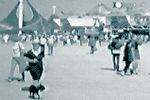 |



BLACK BOX RECORDER, September
2001
September 6-30
Roderick Buchanan, Adam Chodzko, Mark Dean, Sarah Dobai, Douglas Gordon, Graham Fagen, Graham Gussin, Rachel Lowe, Christine Mackie, Kenny Mcleod, Ross Sinclair, Carl von Weiler
The title of this exhibition, chosen by its curators Colin Ledwith and Simon Morrissey, suggests the comparison of the aviation black box recorder with the black box in the corner of all our living rooms – the television set.
Black Box Recorder functions like a flight recorder taken from the cockpit of contemporary artistic activity which presents an abundance of overlapping visual information in one environment; some of which directly references the conventions of film and television, some of which offers narrative or frustrates it, some of which provides periods of mediation or abstraction within the flow of images, but all of which forms some sort of resistance to the expected flow of the televisual image.
Needing to be seen and heard in relatively controlled conditions, it allows more than any other medium the slip-ups and accidents that are usually edited out of ‘broadcast’ media to become the very stuff of the performance – process not as furtive preliminary to proceedings, but the proceedings themselves.
The nature of dominant streams of imagery in television has created a situation where artists’ vide
o is positioned against the accepted structures of film and television – the forms of the moving image that dominate them.
The purpose of the British Council is to enhance the reputation of the United Kingdom in the world as a valued partner. We achieve our purpose by creating opportunity for people worldwide. The British Council has offices in 111 countries, a staff of 7,300 and a turnover of 430 million. The Council's work includes teaching English; running information centres; promoting British education and training; working closely with governments and NGOs on reform and good governance and demonstrating the innovation, creativity and excellence of British science, arts, literature and design.
www.britishcouncil.ru
Information support: OFFICIEL, PTUCH, AFISHA
PANEL DISCUSSION
Video Art: PRO and CONTRA
Within the framework of the British video art Black Box Recorder
Art Media Center "TV Gallery", September 19, 4 p.m.
6 B. Yakimanka; tel.: 238-0269, e-mail: info@archive.tvgallery.org
British Council, Data Exchange Laboratory and Art Media Center "TV Gallery"
Video art has been developing for more than 30 years, its history being stormy and dramatic. Like in other kinds of art based on media technologies, it started due to revolutionary enthusiasm (everyone was able to produce media content!), and with formal aesthetic experiments cultivating the language of the new art.
The language task was completed but the access to mass audience remained unavailable (because TV channels, cinema halls and distributing nets live under commercial laws), so video art began mutating and the ways of video artists broke up.
Orthodox people keep making films showing them at numerous festivals with scanty audience. Opportunists made up video sculpture and then video installation and therefore occupied a fitting (and well-paid) place in the world of "contemporary art". Activists attack present and make their own TV stations and programs with good or bad luck. Business men work for advertising and video clips production.
Digital technologies gave a new start to video development. VJs became an essential part of youth club culture. Also, full-length fiction films are made with the help of video; it is used in multi-media products (presentations, games); digital video is just on the point of capturing the Internet.
In Russia video started developing from the beginning of perestroika and when consumer video cameras appeared.
There are almost no institutions in Russia sponsoring video art, no publications on video art, or educational programs.
Till recently there were no video art festivals in Russia.
The history of video art was not published in Russian.
There is practically nothing available of what the context of video art describes and supposes.
Still video art does exist.
The goal of our panel discussions is to show how much vital and interesting is such phenomenon as video art for contemporary Russia, to trace the vectors of its development, to define the attitude towards the world’s context, to discuss the role of video art and similar practices in the system of contemporary art and beyond its limits. Panel discussions are to become an impulse for the development of the critical context around video art.
The invitees:
Nina Zaretskaya – Director, Art Media Center "TV Gallery", video/media curator;
Yuri Popovsky – video artist;
Andrei Velikanov – media artist;
Ekaterina Dyogot – art critic and curator;
Svetlana Baskova – film director;
Olga Shishko – curator;
Gleb Aleinikov and Alexander Duleiran – film directors;
Alexei Isaev – Director, Media Art Lab;
Vadim Koshkin – media artist and director;
Vladislav Efimov – artist; Aristarkh Chernishov – artist; Arseny Sergeev – artist; and many others.
Moderator – Alexei Shulgin
http://www.britishcouncil.ru
http://www.dxlab.org
Information sponsors of the project: magazines "OFFICIEL", "PTYTCH", "AFISHA"
Publications
video: Adam Chodzko, A PLACE FOR THE END (28 Kbps. fragment, 128 Kbps. fragment); Douglas Gordon, BLUE (28 Kbps. fragment, 128 Kbps. fragment); Mark Dean, GOIN' BACK (28 Kbps. fragment, 128 Kbps. fragment); Rachel Low, MUNICH'72 (28 Kbps. fragment, 128 Kbps. fragment)
The site has been created with the assistance of the "Open Society Institute" (Soros Foundation). Russia
|






